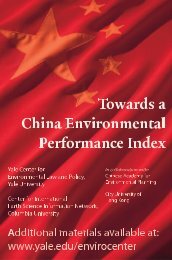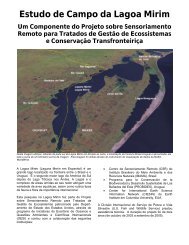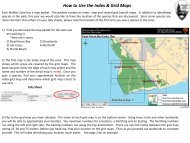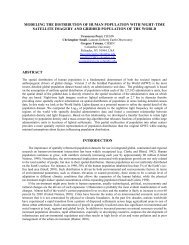In Search of Shelter - Center for International Earth Science ...
In Search of Shelter - Center for International Earth Science ...
In Search of Shelter - Center for International Earth Science ...
You also want an ePaper? Increase the reach of your titles
YUMPU automatically turns print PDFs into web optimized ePapers that Google loves.
2. Adaptation, or failure to adapt?Multiple driversToday, environmental change including climate change contributesto human mobility embedded in linked environmental and socialprocesses. 4 Social system characteristics including social networksplay a mediating role in how environmental change affects whetherpeople move away or stay at home. 5 Migration can represent aresponse to changing environmental and economic conditions,such as a farmer´s choice to migrate due to failing crops andinsecure livelihood prospects. Migration can also exacerbateenvironmental and economic problems in receiving areas. Forexample, urban areas attract migrants seeking better lives.High in-migration contributes to crowding and environmental/sanitation issues in slums.Studies also point towards urbanization as a <strong>for</strong>ce driving regionalwarming (heat islands) which canexacerbate drying trends, among otherproblems. 6 Some <strong>of</strong> these cities, suchas Dhaka, Buenos Aires, Rio de Janeiro,Shanghai and Tianjin, Alexandria andCairo, Mumbai and Kolkata, Jakarta,Tokyo and Osaka-Kobe, Lagos, Bangkok,New York City, and Los Angeles, arelocated in areas exposed to sea levelrise. Sea level rise could motivateresettlement, <strong>for</strong>ced migration, orother <strong>for</strong>ms <strong>of</strong> human mobility. 7Environmental change has a multipliereffect on other migration drivers. 8 Asan illustration, land degradation inNiger has undermined the resilience<strong>of</strong> farmers to recurring drought. 9More erratic weather, rising sea leveland other climate change impacts2How many people will be uprootedby environmental change?Estimates <strong>of</strong> the numbers <strong>of</strong> migrantsand projections <strong>of</strong> future numbers aredivergent and controversial, ranging from25 to 50 million by the year 2010 11 toalmost 700 million by 2050. 12 IOM takesthe middle road with an estimate <strong>of</strong> 200million environmentally-induced migrantsby 2050. 13 The first controversy concernsthe categorization <strong>of</strong> people made mobileby environmental factors including climatechange. Some organisations refer to“environmental refugees” while others,following the strong position <strong>of</strong> UNHCR,stress that the word “refugee” has a specificlegal meaning in the context <strong>of</strong> the 1951Geneva Convention Relating to the Status<strong>of</strong> Refugees. 14 Terms such as “environmentalmigrants” and “environmentally motivatedmigrants” have, there<strong>for</strong>e, been introducedas alternatives. 15will exacerbate both migration pressures and environmentaldegradation. 10What is certain from empirical and theoretical research onenvironmentally-induced migration, in all its varieties, is thatenvironmental change is one <strong>of</strong> many contributing factors.Climate change & mobility: framing the issueTerms and concepts such as environmental or climate changemigration, environmentally-induced or <strong>for</strong>ced migration, ecologicalor environmental refugees, and climate change refugees are usedthroughout the emerging literature, with no general agreement onprecise definition. 16 The main reason <strong>for</strong> the lack <strong>of</strong> definitions <strong>for</strong>migration caused in part by environmental change and degradationis linked to two issues: the challenge <strong>of</strong> isolating environmentalfactors from other migration drivers,and the possible institutional andgovernance implications <strong>of</strong> definingthis range <strong>of</strong> environmentally-relatedmigration. 17This report relies on a working definitionprovided by the <strong>In</strong>ternational Organization<strong>for</strong> Migration (IOM) <strong>for</strong> “environmentallyinducedmigrants” including those mademobile in part due to climate change:“Environmental migrants are persons orgroups <strong>of</strong> persons who, <strong>for</strong> compellingreasons <strong>of</strong> sudden or progressive changesin the environment that adversely affecttheir lives or living conditions, areobliged to leave their habitual homes,or choose to do so, either temporarily orpermanently, and who move either withintheir country or abroad.” 18©CARE/Kate HoltEmergency housing <strong>for</strong> internally displaced persons inthe Democratic Replublic <strong>of</strong> the Congo.







